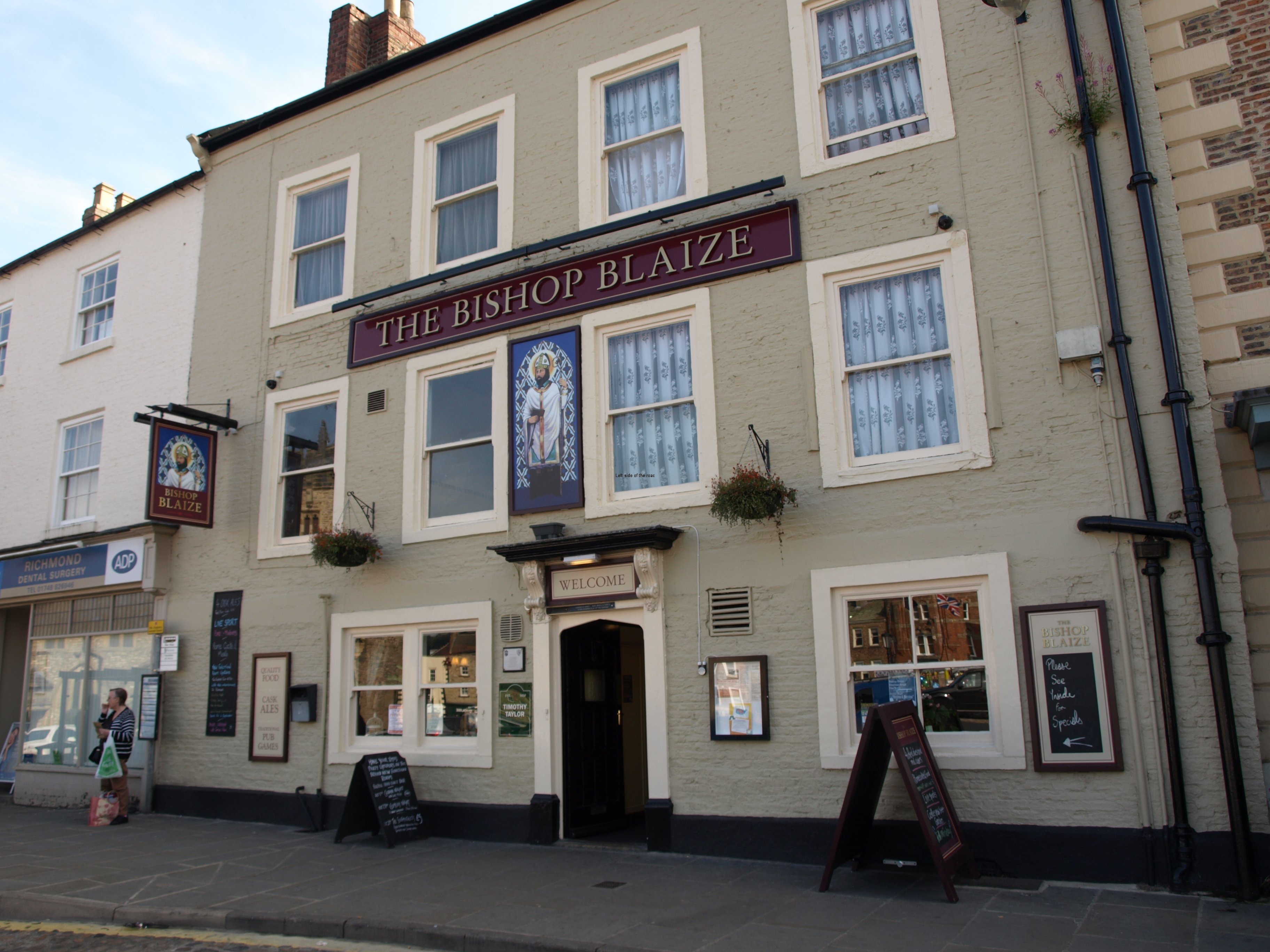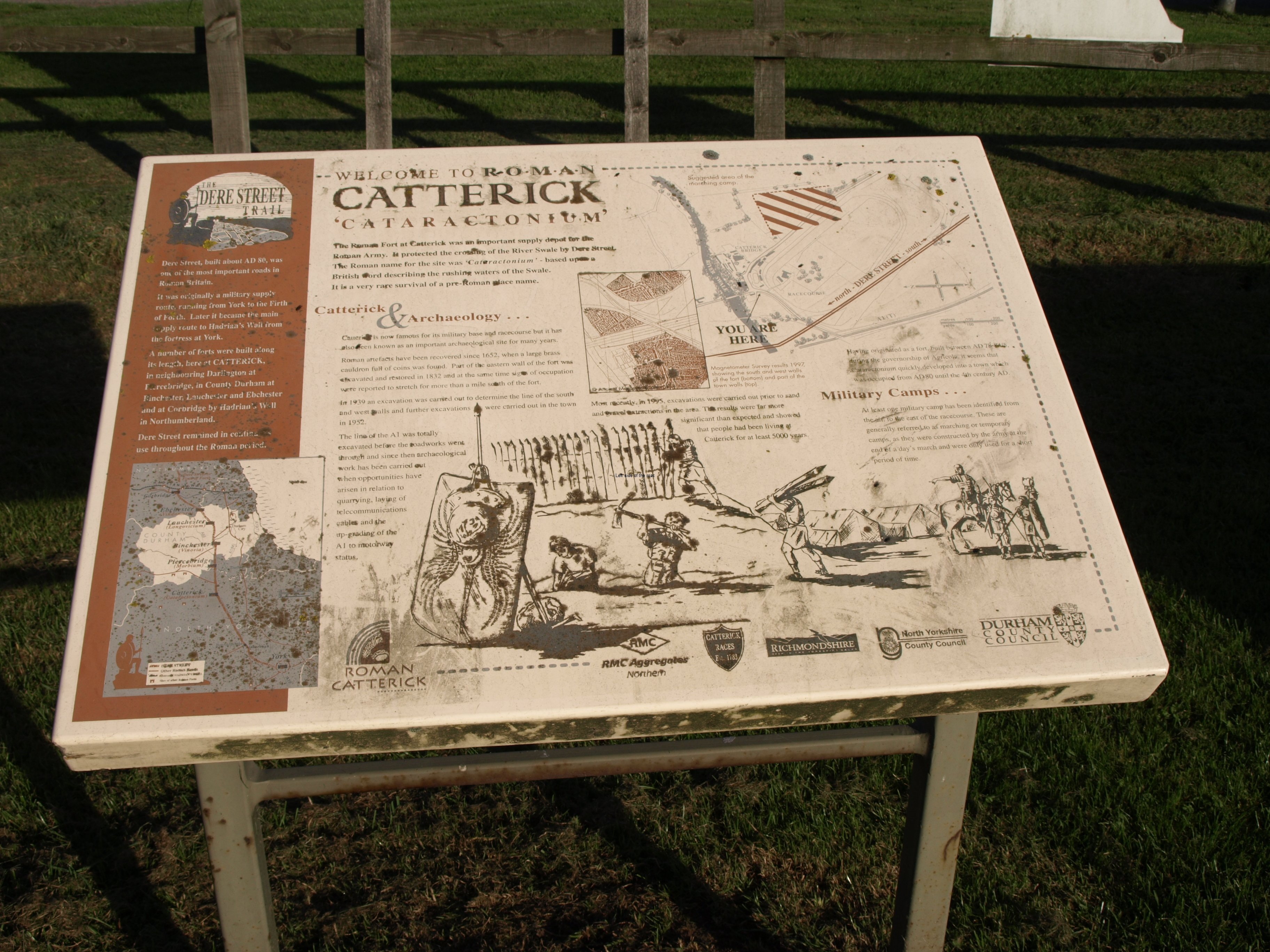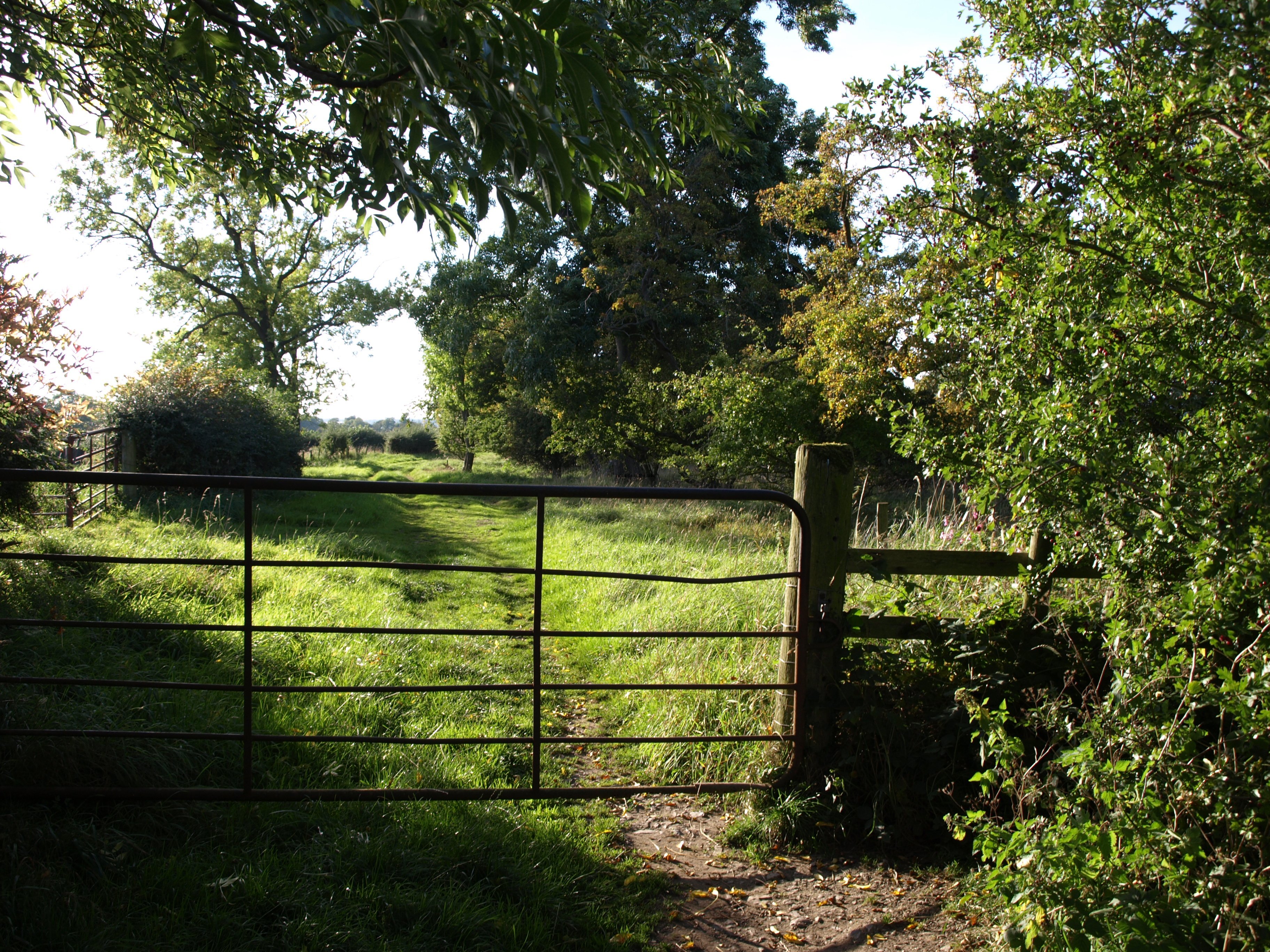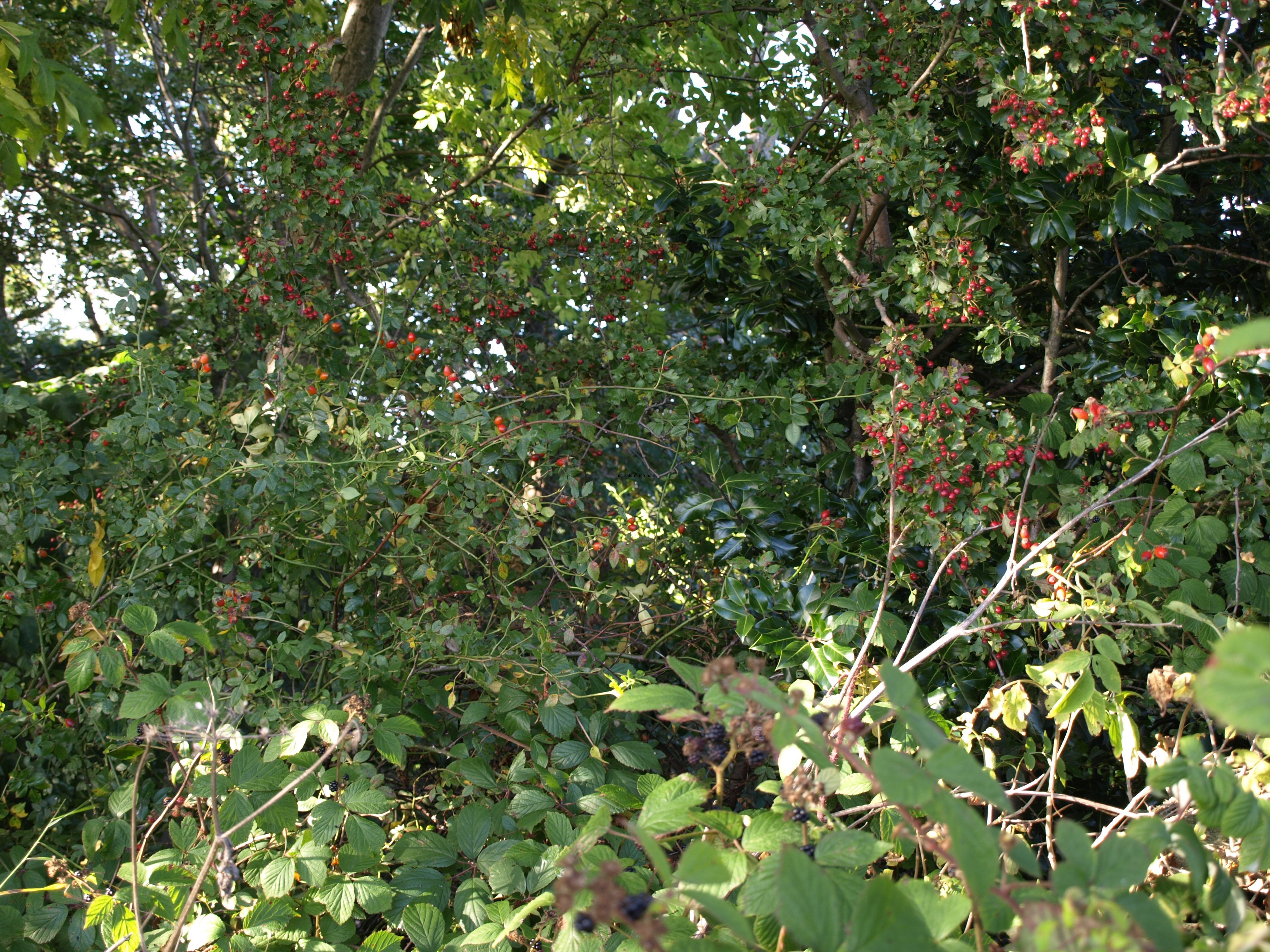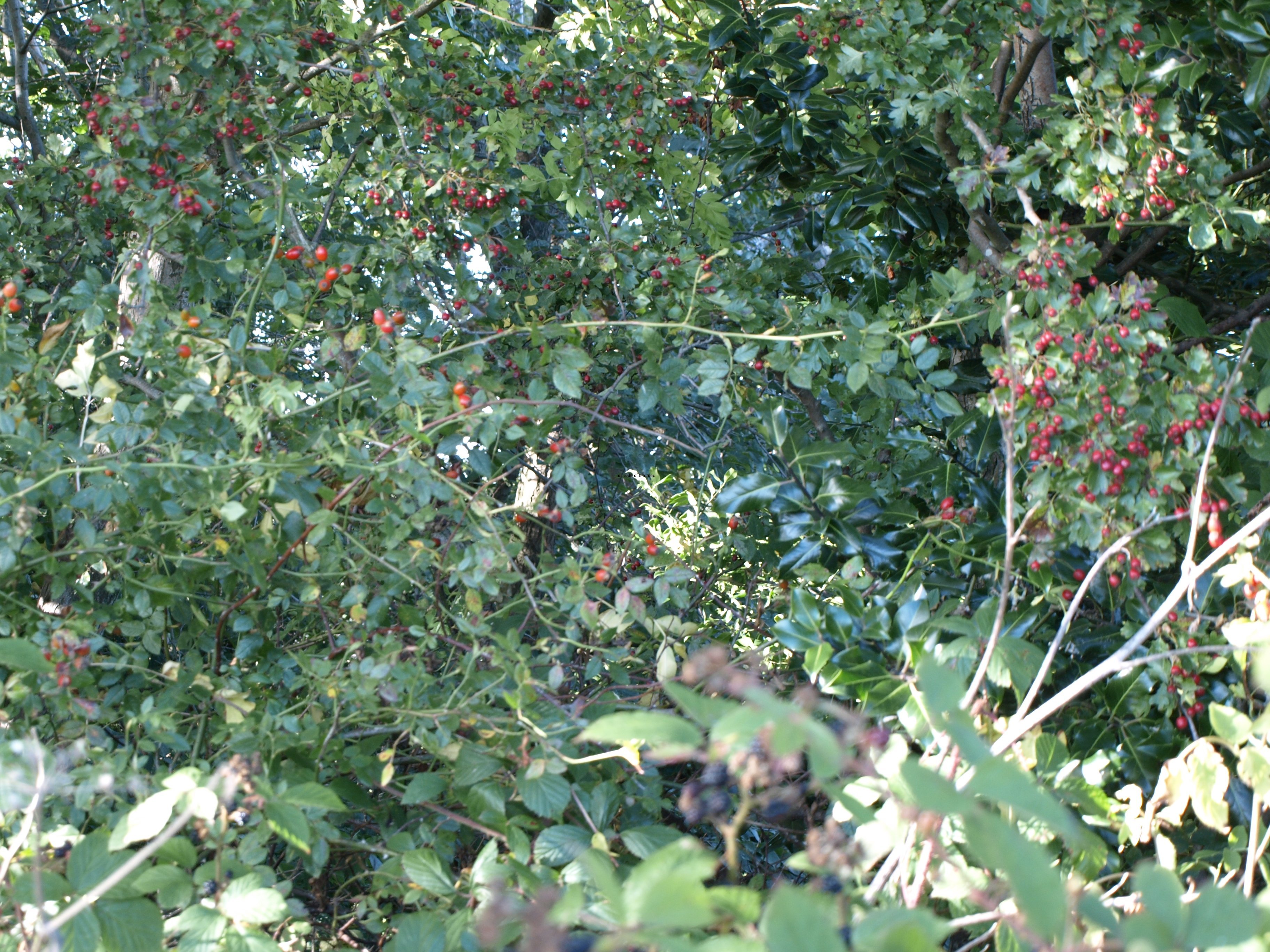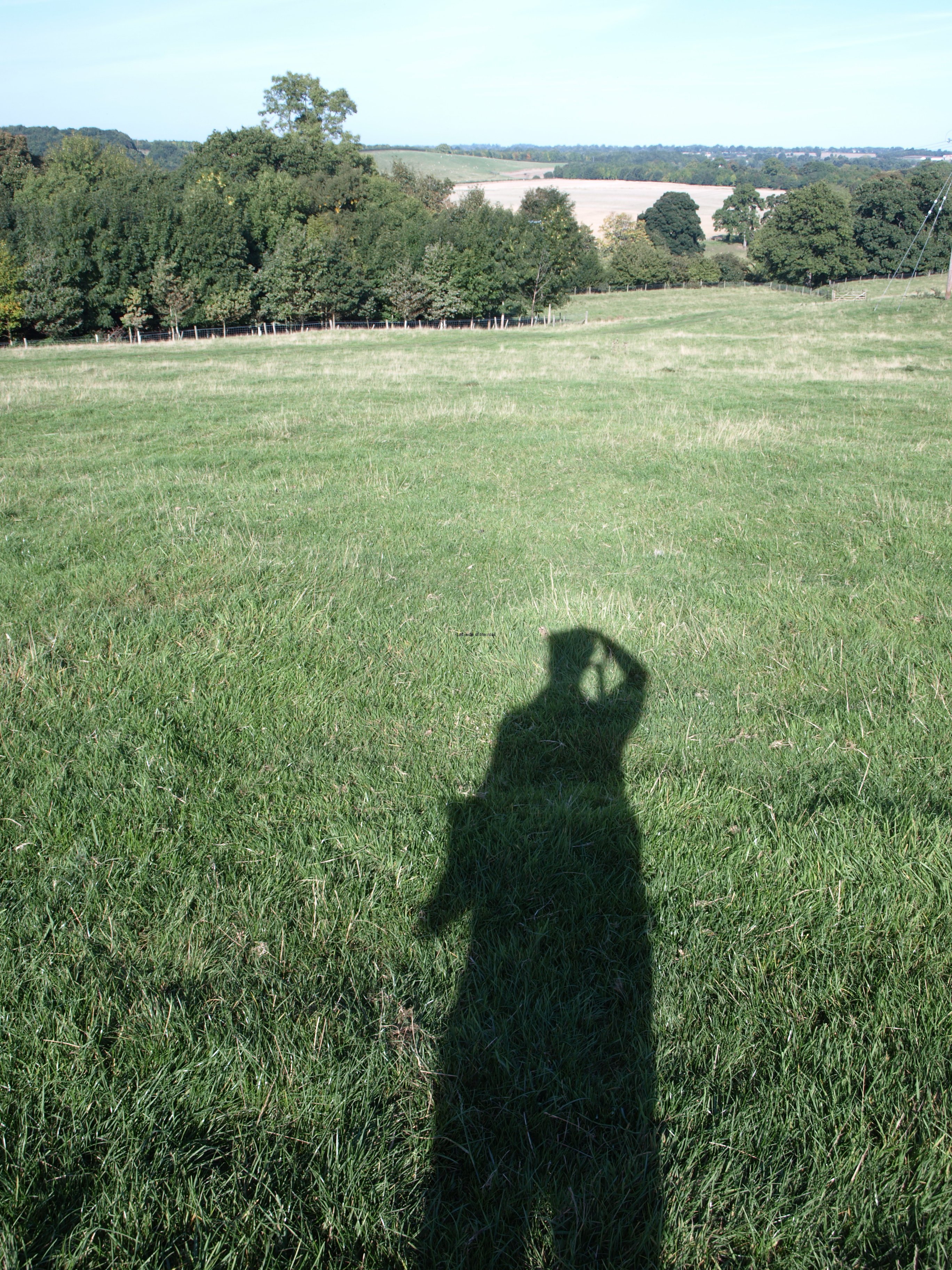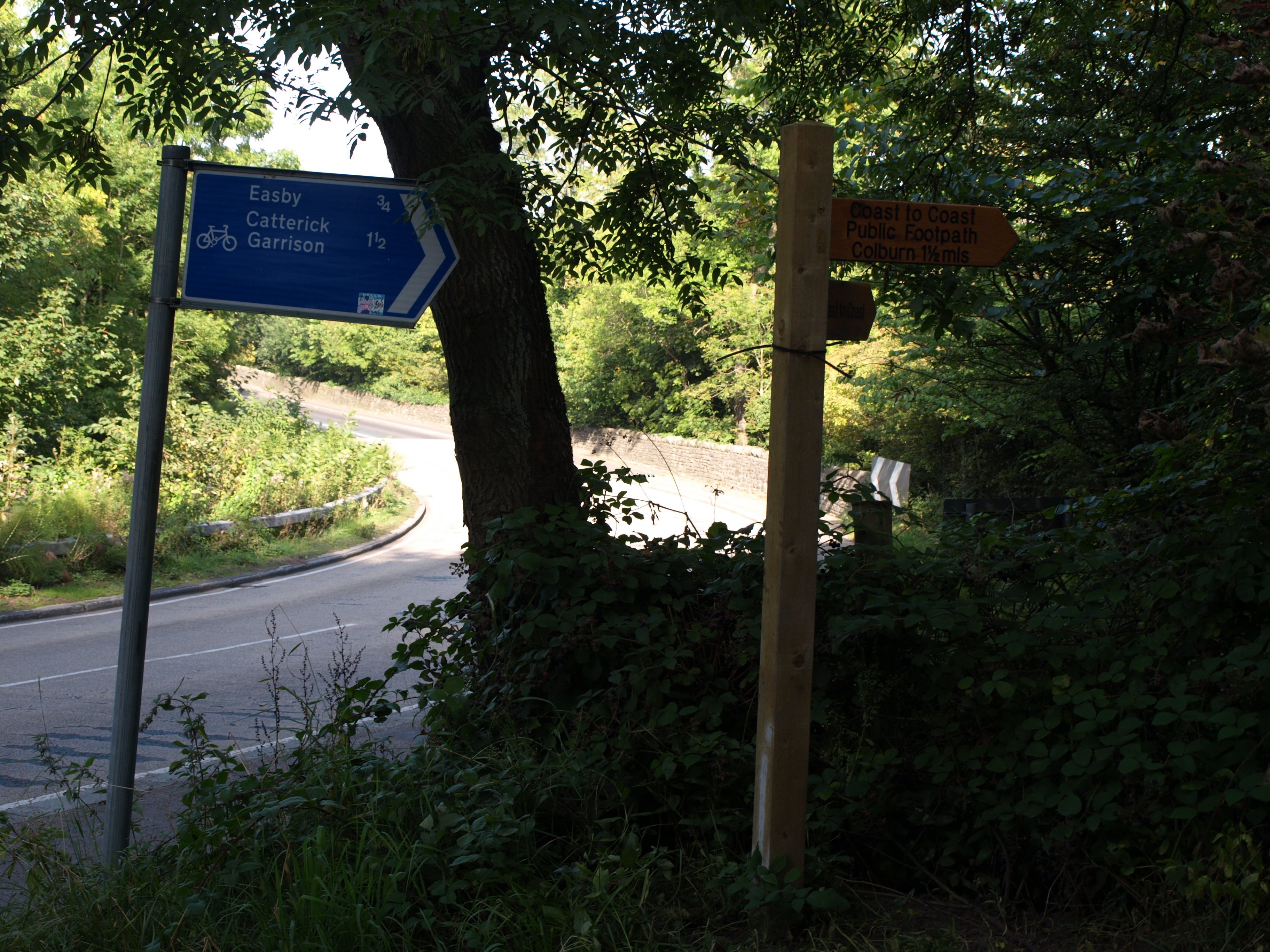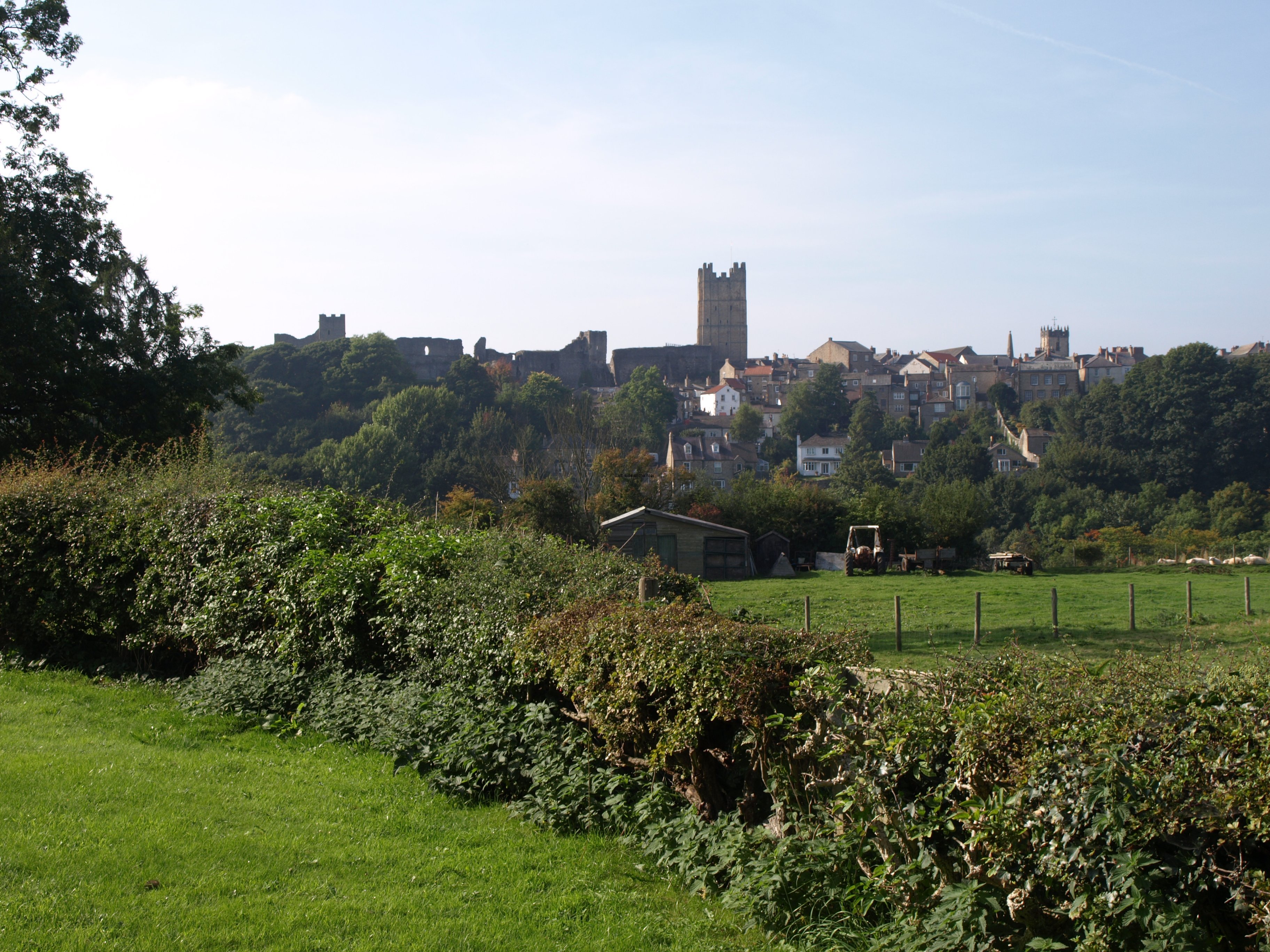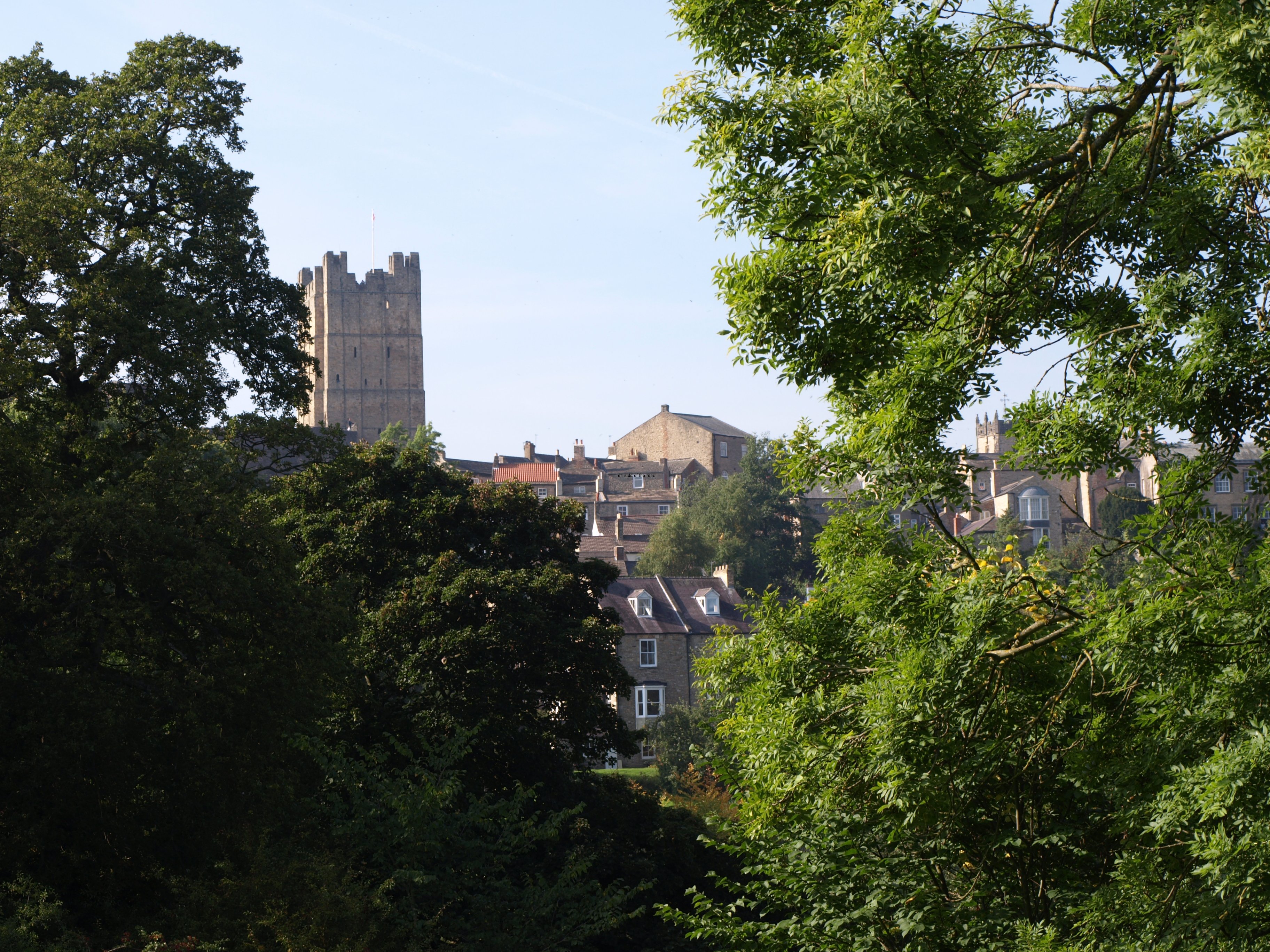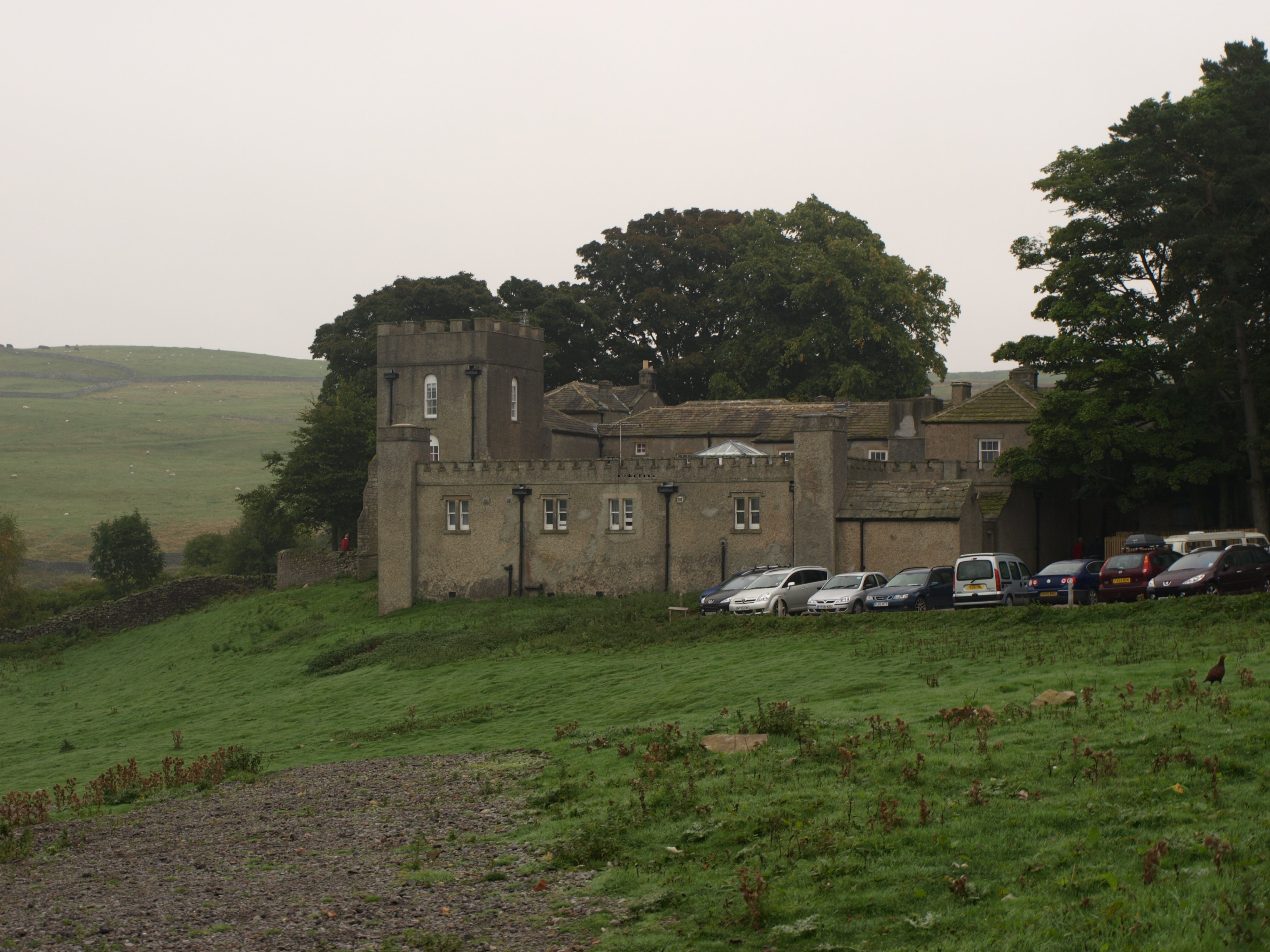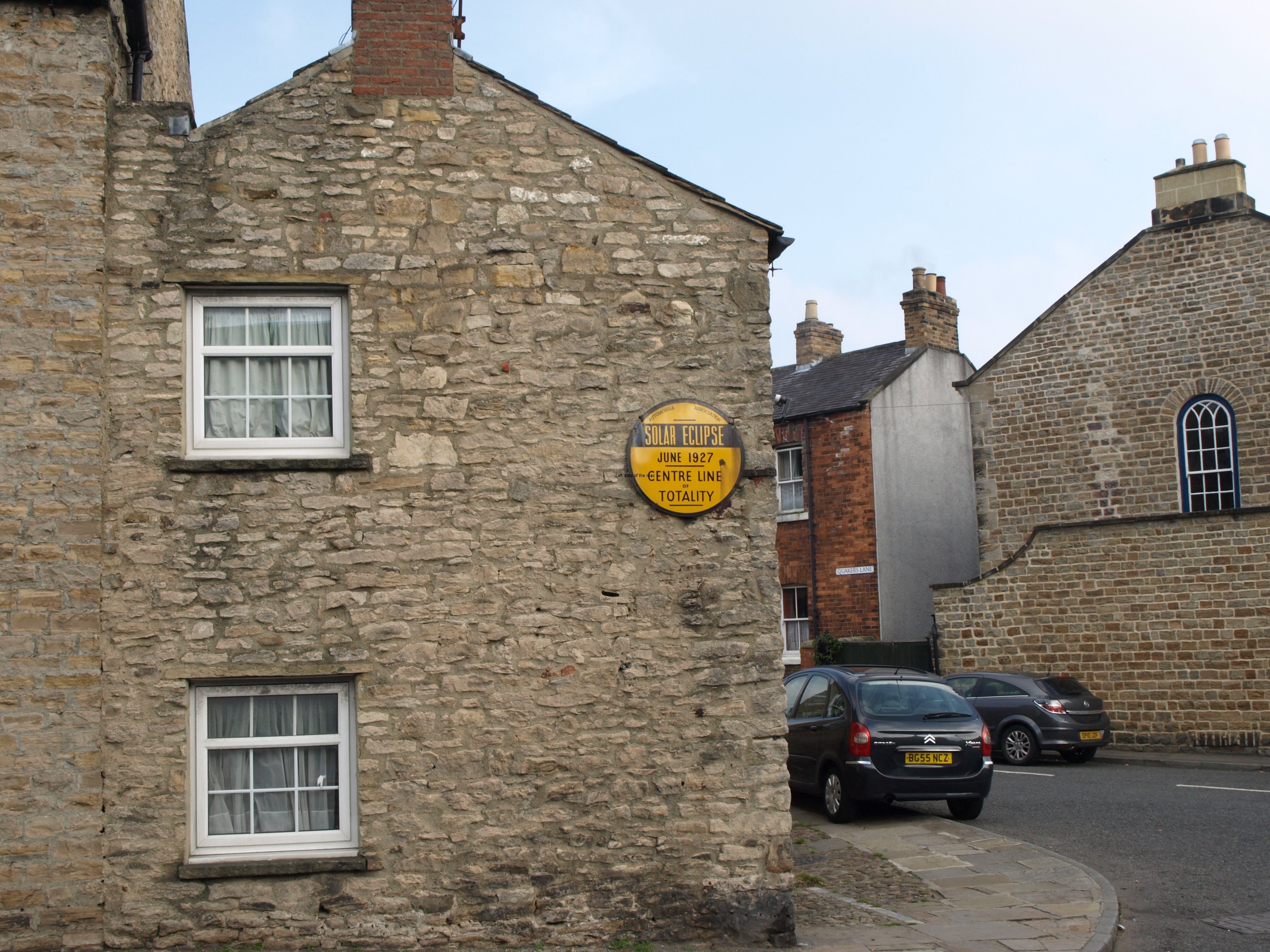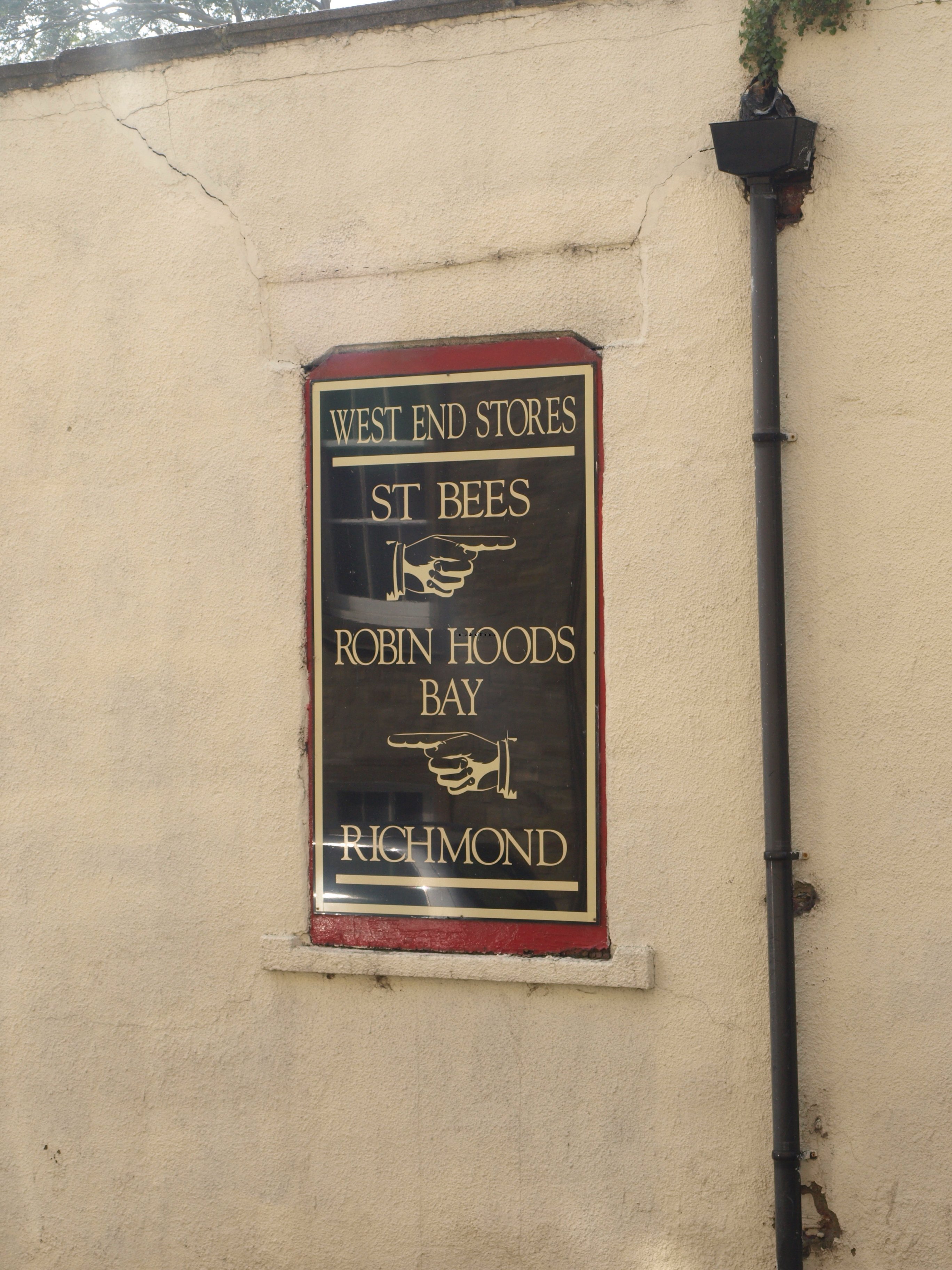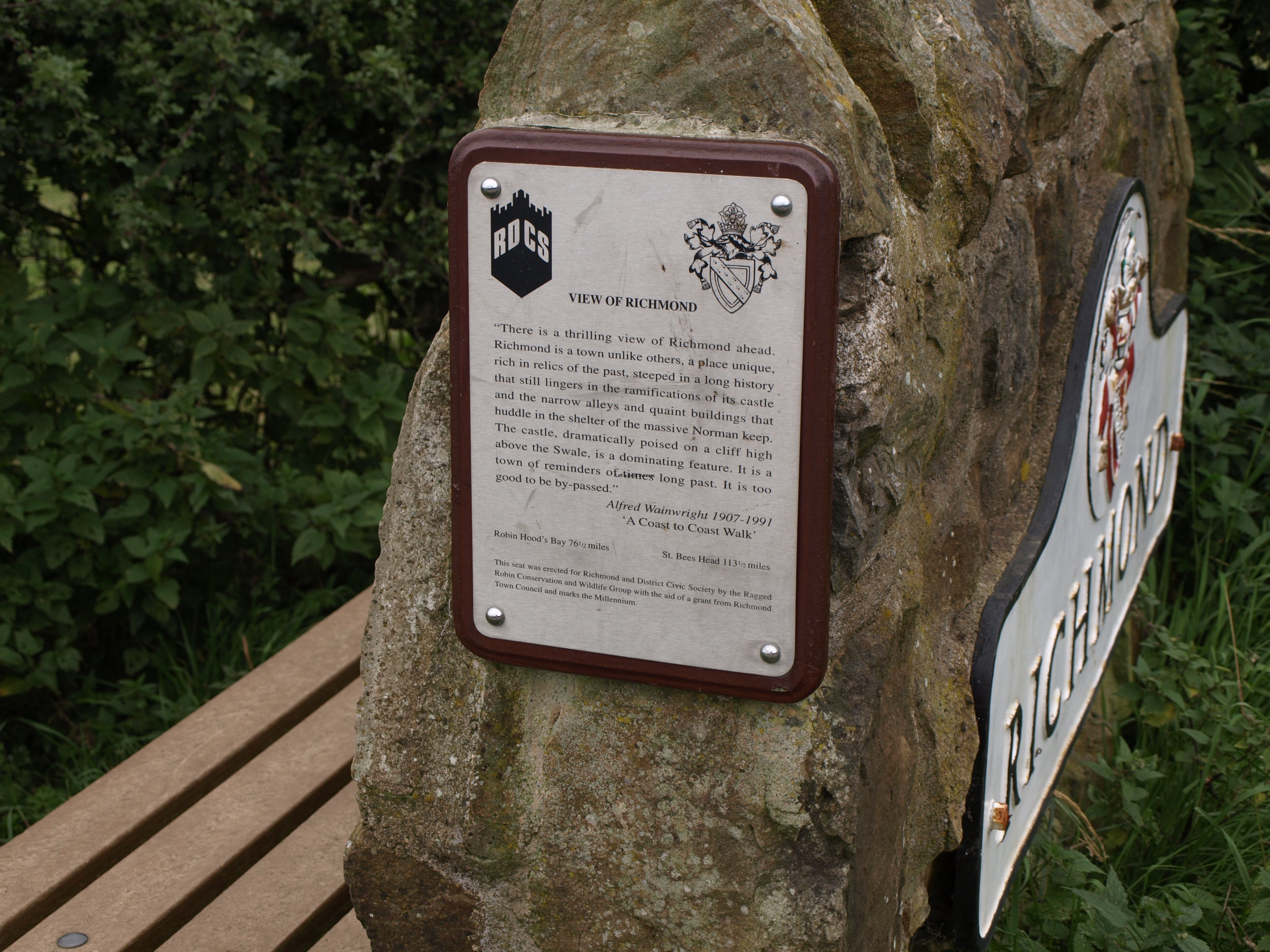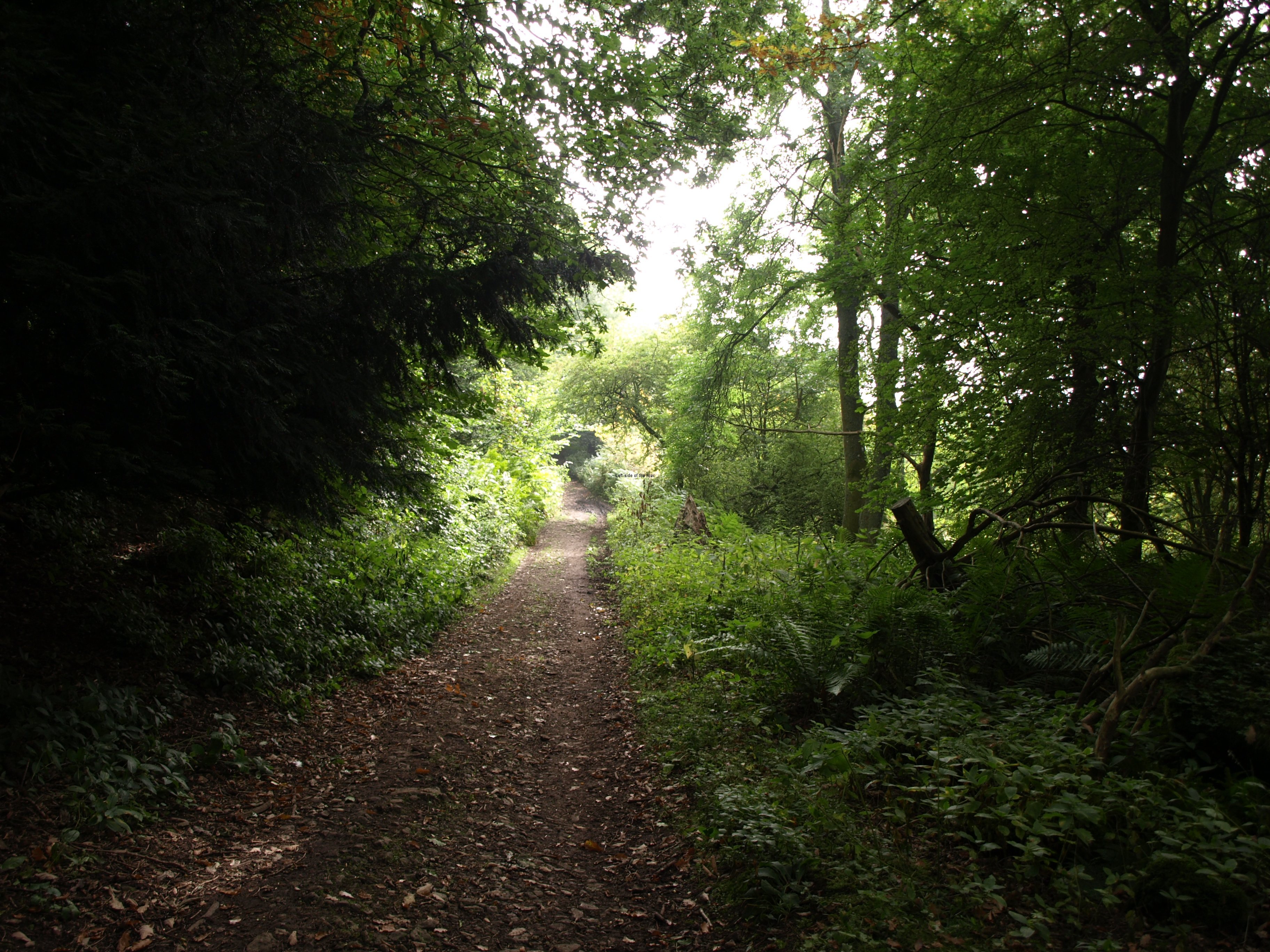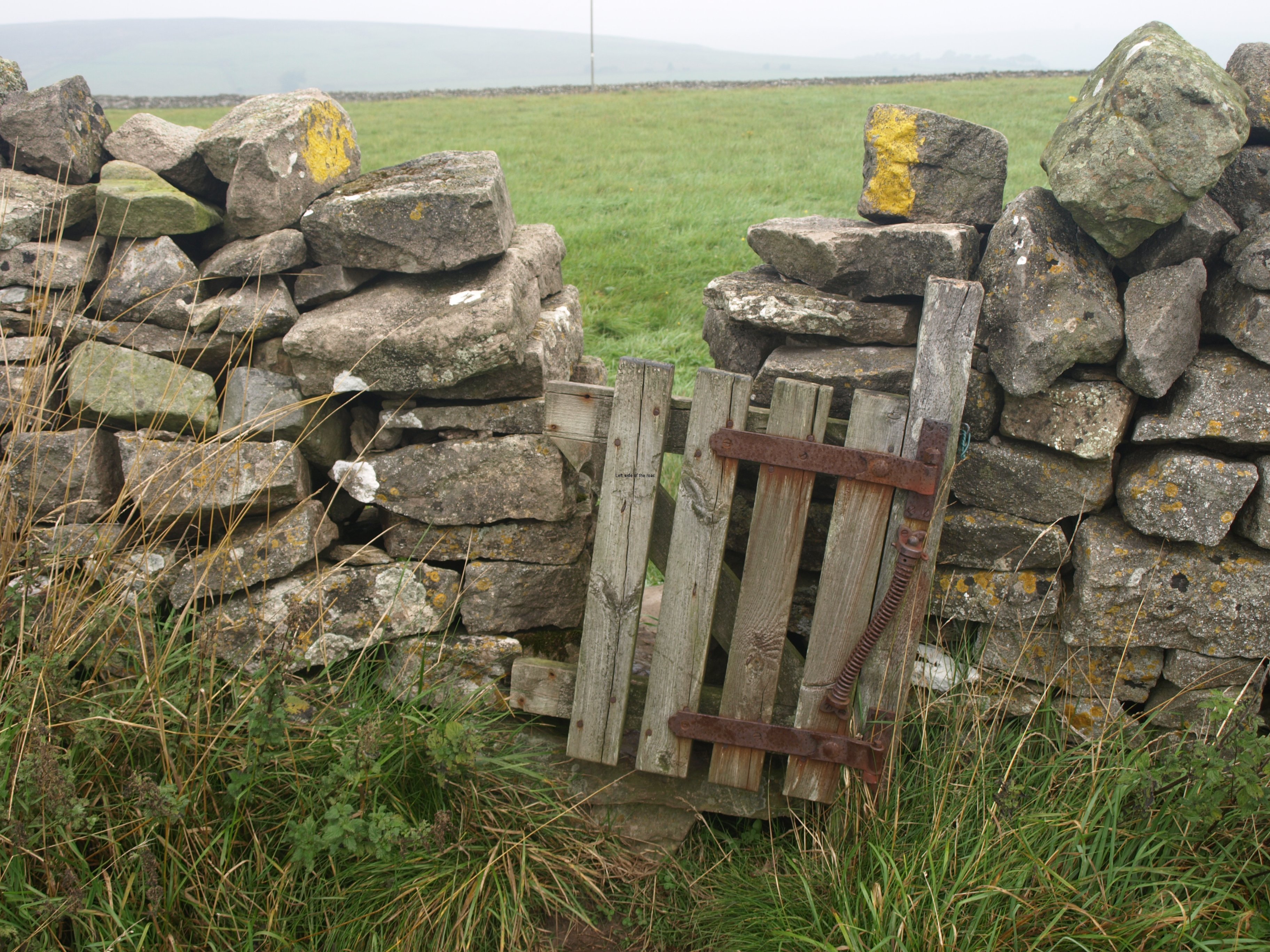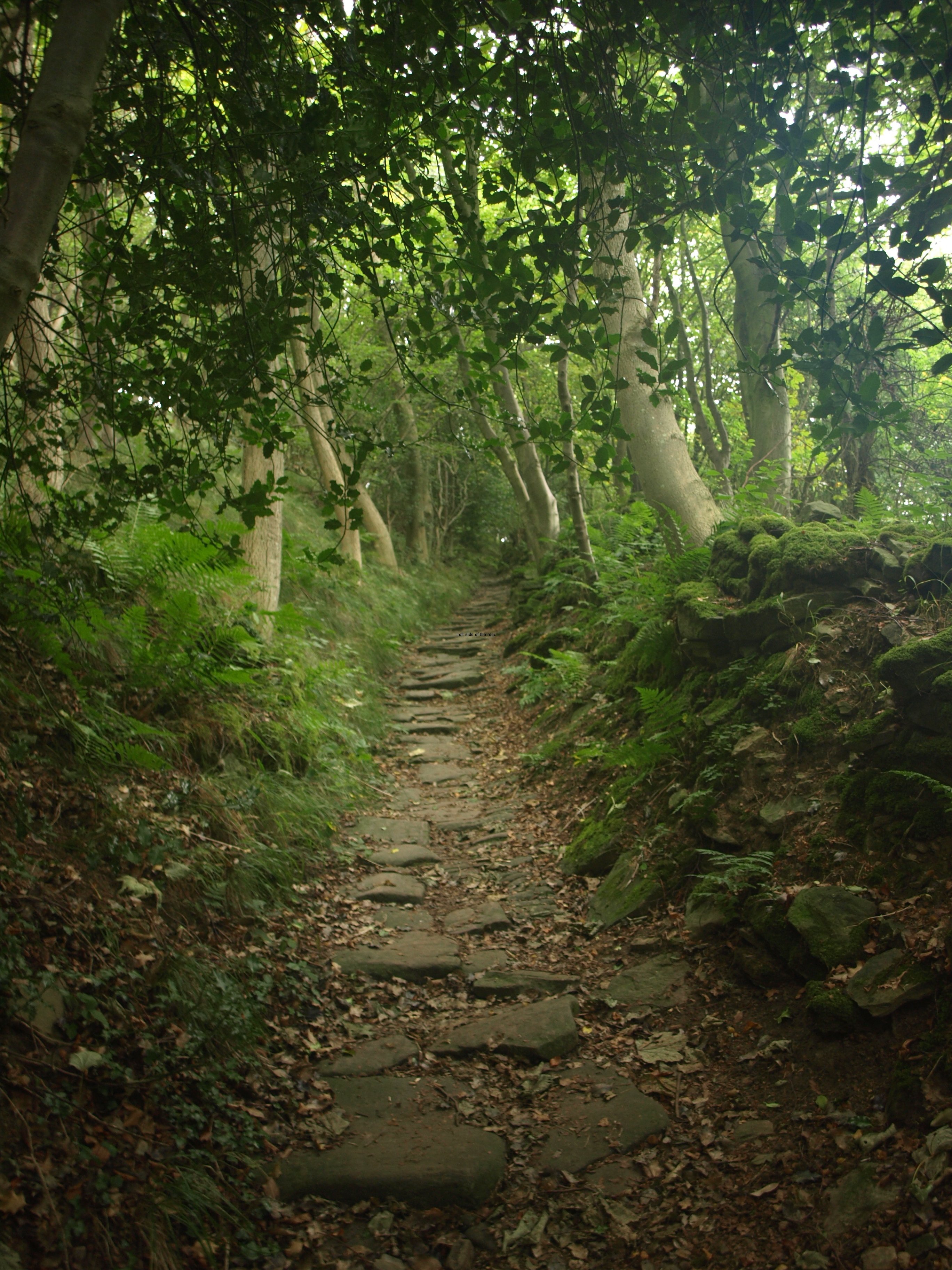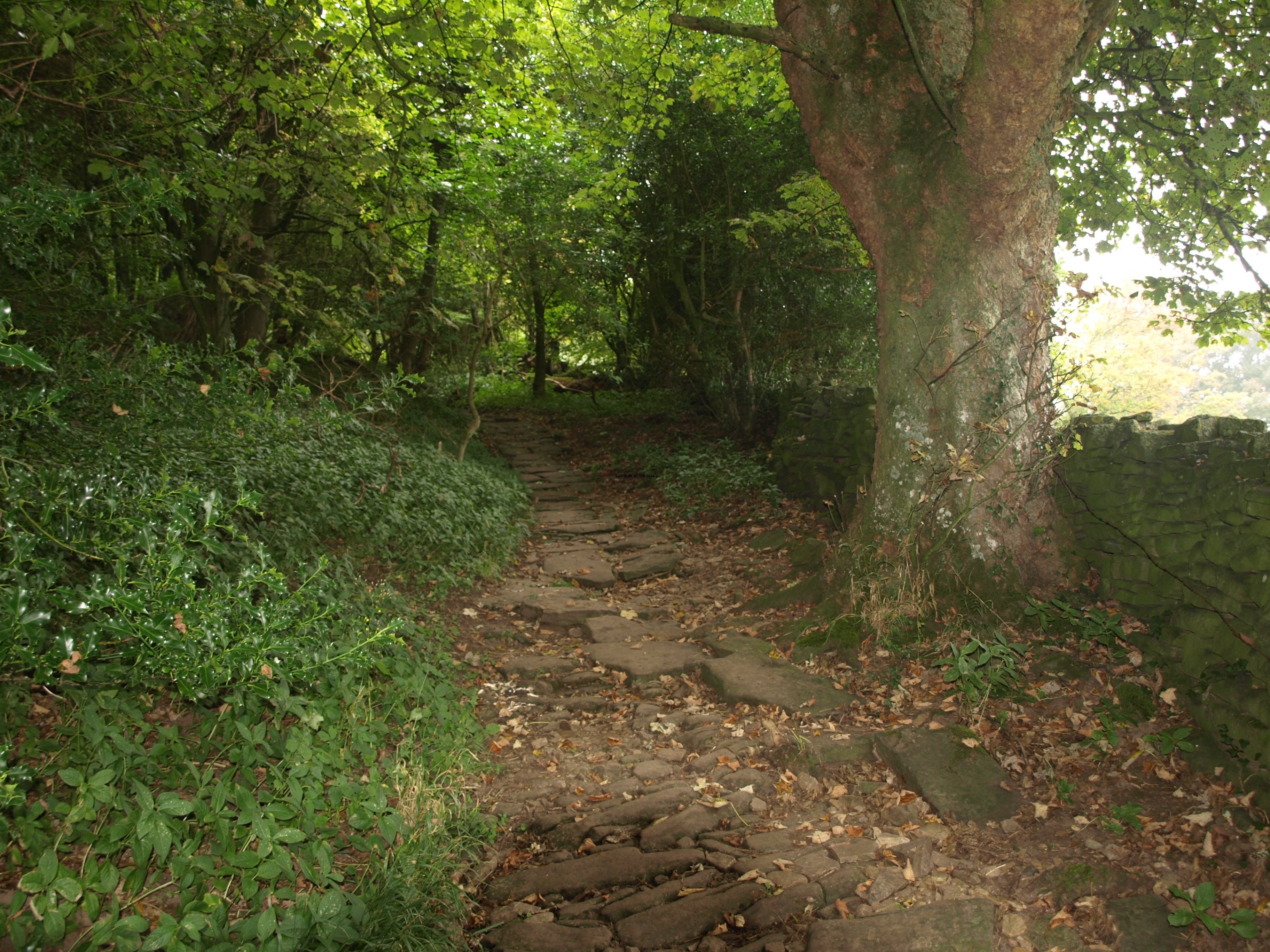Chapter 11 – Reeth to Catterick Bridge
The day of joining the army
After such a good day yesterday I was somewhat disappointed when I first looked out of the window to see that it was misty. Typical, I thought, I don’t walk the sun shines, I do and it’s cloudy and overcast. But my pessimism wasn’t really justified. As I walked down the (long) hill back to the river and the valley I would be following, more or less, for the rest of the day.
Normally I was leaving at 09.00 but as today was going to be another long one, and after considering what I still had to do as I sat in the pub on my rest day, I thought that an earlier start wouldn’t do any harm and so started off at 08.30 – just in time to see the ‘hunters’ gathering a little further down the hill. As I’ve got closer to the higher Yorkshire Moors I’ve come across more and more evidence of gunmen after daft birds. I must admit I didn’t know that it would be such a major part of travelling through the countryside at this time of year.
But it lacks the glamour of the times when Grinton Lodge was the haunt of the rich and not the impoverished as it was now as a youth hostel. <!–more–> The gunmen arrive in their 4 x 4s, park up and when everybody has arrived they jump into ex-Army all terrain vehicles which takes them to their allotted place on the moors to wait for the pheasant and grouse (I don’t know if they are strictly segregated) to fly overhead so they can blast at them with anything up to a hundred pellets (I looked at a webpage in order to get accurate figures but found it so boring I’ve just picked a big number as a guide). However, ‘hunters’ are becoming ecological and now there are steel alternatives to lead. There are EU regulations, especially when shooting waterfowl where there’s a risk of lead pollution of ponds but I don’t know if that still is enforceable on moorland.
But even though it’s not cheap to go hunting it seems to lack the style of the past. Where were the flunkies dressed in suitably servile clothing to serve the kedgeree and champagne for breakfast? Where was the local drunken lord who was half shot by the time they went on to the moors and was just as likely to shoot his own foot off, or the head of a beater, than ‘bag’ a brace of grouse. Where was the display of ostentation that rubbed the hoi poloi’s nose in their poverty? It must happen somewhere but not as public as in the past. When I was having my breakfast in the Black Bull on the Friday morning the owner of the pub mentioned that the beaters had been in early on, but that they weren’t ‘posh enough’ for the gunmen. So where they go in Reeth I never discovered.
Anyway, they didn’t shoot me, just to make sure that the guns worked and I arrived at the bridge over the River Swale (by the St Andrew’s church) and picked up the route of the Coast to Coast, quite content that the sun had already burnt away the mist and the sun was being reflected from the dew drops on the grass.
And after my concerns about the pack a couple of days before it seemed quite comfortable – and remained so for the rest of the day – so it seemed that the day off and the passage of time had allowed me to adapt to my burden.
When I was planning this stage before leaving home I decided that I would go away from the suggestion in the book and carry on after Richmond to Catterick Bridge. This would add another 5 or so miles (and a couple of hours) to the day but that would have the effect of moving me on. From now I have to grab the miles when I can and, anyway, there seemed no point in arriving early in the afternoon in Richmond to then go sightseeing as I had already decided that the two activities, walking the whole route and a bit of culture, were not really compatible. I would grab the culture if it arose but wouldn’t go looking for it.
And the day didn’t seem (and didn’t work out to be) very onerous. The walk was through meadows and farmland, (livestock rather than arable, in the main), the occasional hamlet (that seemed more second, country homes than a living community (though I might be wrong here), a few short stretches through woodland all, more or less, on the northern side of the Swale valley – at least until arriving in Richmond.
But a few small points. I’ve said that I’ve found the guide-book I’ve been using accurate but this morning I just couldn’t find the continuation of the marked path. Nothing to do with visibility (as it was on the way up to Kidsty Pike) as I was on a road not far from, and running parallel to, the river. I never found it as I realised that I had the choice of going up into a few fields just to come down again on to the road on which I was standing. Thought just keep along this quiet (nothing passed me in either direction) road and get on the path when it’s important.
Another point is the naming of some of these sections, that’s not just on the C2C walk, but everywhere. There’s an old priory (now used as an adventure centre) and beside this a section through woodland that climbs quite steeply but which was paved at the time of the priory’s heyday (it disappeared as part of the dissolution of the monasteries in 1540). This pavement is called the Nun’s Steps (there are 375 of them) but why? Did the nuns get on their hands and knees and lay these stones? Did they quarry, or collect, and shape the stones to fit? Did they maintain the path as over time water running down the best constructed paths will cause damage? Certainly not, but they still get the credit. I know it’s just a moan which goes nowhere but worldwide structures, small to the monumental, take the name of those who might have commissioned (in rare cases had paid for) the building but had no direct involvement in the construction, and certainly never got their hands dirty.
We had to wait until the twentieth century with the constructions in the Soviet Union, China and Albania before the credit for the construction actually was ascribed to those who actually paid for, designed, worked on and completed the project. Now many of those sites have been stolen and privatised and probably bears the name of some insignificant individual whose declaration of theft is made in the change of name.
And blackberries. I haven’t mentioned blackberries before but they have appeared virtually everyday on one or more sections of the walks to date but very few people seem to pick them any more, and they will tend to be older women who live near a good source of berries and have just carried on doing what they started as children. The idea there are things available in the wild just doesn’t seem to be attractive to many people.
I remember having a conversation with a teacher who was a member of one of my walking groups in Spain many years ago. This was prompted by the same seeming lack of interest of Spaniards in such autumn crops. The teacher said that even if she attempted to suggest to groups of children that they could pick and eat the berries they would look at her as if she were suggesting something filthy, disgusting and taboo. Yet another product of our so-called civilized society where, in answer to the question ‘where does milk come from?’, many children will answer ‘the supermarket’.
I don’t go out purposely to pick these fruits and berries (although I must remember to go over to the Wirral sometime after I get back home to pick sloes in order to make sloe gin) but I always will test what’s there if I am walking through the countryside at this time of year. I must admit that the experiences haven’t been too good on this trip. Most of the blackberries, although ripe, have tended to be nondescript or even bitter on occasions. I think there was only one location where the taste reminded me of what I considered a blackberry should be like. That, I’m sure, is down to the crazy weather conditions of 2013 and the variations in different parts of the country, even between the west and east sides of the north. I can’t remember where but someone told me that the hazel nut crop this year had also been disastrous due to the fickle weather conditions, but don’t know how true that might be, or how local its effects.
On the very quite road that brings you to the top end of Richmond there’s a large boundary sign that looks incongruous if it wasn’t for the Coast to Coast walk. This sign is part of a bench and also for a small plaque with a quote from Alfred Wainwright about the ‘thrilling view of Richmond’. This got me thinking of how Wainwright seemed to become excited over the most simple and basic of matters. To him everything he saw was a wonder, something exceptional and spectacular.
Now I’m not going to say that there are some impressive natural, and man-made, ‘wonders’ in the UK and even along the C2C path – although due to the weather conditions this time I didn’t see many of them at their best, but, then again, I didn’t see them at their worse. But there comes a time when you have to pull back on the superlatives. From that point I could barely see Richmond, because of the trees in the way, and don’t understand why Wainwright was so excited, unless he had been walking for a long time or in particularly bad weather and he was looking forward to a pint (did he drink?) and a sit by an open fire.
I also don’t know if he did any travelling outside of the north of England. His approach is always so parochial and his references always seem to return to his ‘beloved’ Lake District. I’m sure if he had been asked to describe his plate of Cumberland sausage and mash (which would have to have been his favourite dish) he would have seen references to his favourite Haystacks and would have seen The Lion and The Lamb in the peaks of the mash.
But I speak ill of the great man. If I’m not careful there will be a fatwah taken out on me under the leadership of Ayatolla Bradbury.
At the time of taking the picture I didn’t notice the mileage at the bottom of the plaque, still 76½ miles to go!
As I’ve mentioned above I wasn’t going to spend the night in Richmond but as I arrived there at lunch time (just around one) I decided to have a pub break and then continue on to Catterick Bridge. However, Richmond obviously wasn’t pleased by my decision and as I went through the very last stile of the day – a day with a lot of them – my jacket on the top of my rucksack got caught on one of the poles of the stile, I stepped back to release myself and knocked my ankle against the edge of the pebble reinforced concrete that fixed the stile in place. So having started the day thinking that foot problems were something of the past I knocked my Achilles tendon hard against unforgiving concrete and I started my entrance into Richmond at a hobble.
I didn’t before I arrived, and still don’t after leaving, know a great deal about Richmond but one quirky bit of information about the place was that during the Total Eclipse of the Sun in June of 1927 the Centre Line of Totality passed through a house on the western outskirts of the town, marked by a plaque (strangely?) sponsored by the AA – the car organisation, not the drinking one.
The decision to merely pass through Richmond was mainly due to one of time and the desire to get a few more miles behind me but another reason was the fact of it being a garrison town, the home of the Green Howards (a museum of that regiment being in the main market square of the town) and one of the army’s biggest barracks/garrisons/centres – don’t know how best to describe it – of Catterick only being a few miles down the road.
I don’t like garrison towns. During the 1970s and 80s the army must have been told to keep a low profile when off duty after they had become accustomed to kicking in the doors of working class people in Northern Ireland and the IRA decided to counter-attack by placing bombs in British pubs. This situation was relaxed a little in 1982 when the ‘heroes’ returned from the Malvinas. When down in Plymouth just after that despicable little war I went into a pub at the town end of Union Street – not a pub I was accustomed of going into and which was never any good anyway so don’t know why I did so – only to find that a recently returned regiment was celebrating the fact that they had survived. Most of them had joined up expecting, assuming and, no doubt, hoping that the most that would be asked of them was to terrorise the local populations of Belfast and Derry and were, equally no doubt, shitting themselves on their way down to the South Atlantic. But now they were ‘real’ battle hardened soldiers and let the world know – post traumatic stress disorder not being in vogue at that time.
To go into a pub regularly frequented by soldiers when the British army has been engaged in a real fighting, killing war for more than 12 years and where most of those who had joined up had done so knowing what to expect didn’t really appeal to me. The place in the centre of Richmond I chose – the main, market square seems quite well endowed with pubs – was totally at random and worked out well but expensive. I don’t know what it would have been like on a Saturday night.
(There’s a new relationship between the people of Britain and the armed forces, particularly the army, which is different from what has existed in the years since the end of the Second World War in 1945. After that period of madness and carnage (even greater than in the war that was supposed to end all wars and which changed the look of virtually all villages, towns and cities with the construction of war memorials to those who had died between 1914-18/9) the population, in general, was tired of killing. However, the ruling class and all the governments ever to have been in power in this country never tire of sending men (and now women) to some far off land to kill for the sake of their interests.
Even though most soldiers wanted nothing more than getting out of uniform the Labour Government (elected with a landslide in 1945 and with the promise of a ‘new dawn’) who sent troops out to fight against the Greek people and in support of the fascist monarchists. Conscripts were caught up in this but there were those who had got the taste of killing and welcomed the opportunity to satisfy their thirst for blood in whatever theatre of war they might be sent.
(Similar groups of killers came to prominence after the First World War. In Britain these psychopaths joined the Black and Tans in Ireland and in Germany the Freikorps were those who fought against the German revolutionaries (murdering Rosa Luxemburg and Karl Liebnecht) and then, later, morphing into the storm troopers of the SA and the SS of German Nazism.)
After Greece and then Korea (which was still very much a conscript army on the British side) the ‘professionals’ showed their true mettle in the anti-colonial liberation wars in Malaya (with British soldiers being photographed with the severed heads of Malayan Communists) and Kenya (in what was known as the Mau Mau uprising – details of the barbarity of the British forces’ actions there, and the sanction from the highest levels in the British government, having recently come to public prominence). Aden (with Colonel ‘Mad Mitch’) and Cyprus followed this but they don’t get referred to very often as they were ignominious failures for the British.
Then came Ireland.
Before the British troops began their next, long-term occupation of the streets of what is supposed to be a part of Britain (and which didn’t seem to bother the vast majority of the British population) young men were urged to ‘Join the Professionals’, the advertising slogan used by the army. That disappeared from out TV screens and advertising hoardings as it became increasingly clear that professionalism meant kicking in the doors of the Catholic working class in the middle of the night. And for much of the 70s and 80s (with a brief respite for the disgraceful Malvinas invasion) the army took a very low-key role in the nation.
Then came the ‘War on Terror’.
And the invasions of Iraq and Afghanistan. To distract attention away from their illegal and immoral acts the politicians decided to make heroes of those soldiers who had been sent out to maintain imperialism’s financial and geo-political interests in the Middle East. So first we had the bizarre display of patriotism and grief with a huge proportion of the small Wiltshire town of Wootton Bassett turning out on the streets whenever a British service man or woman’s body was returned to the UK. (This wasn’t appreciated by many of the higher officers, after all this was only drawing attention to the fact that soldiers were dying in that far off country.) And then, not surprisingly by the Labour Government, five or so years ago Armed Forces Day was introduced, as yet another cynical manoeuvre of politicians to distract attention away from their policies and to shine the spotlight on ‘our’ boys and girls fighting for ‘us’.
So now we have relations of killed soldiers stating that their son/daughter/husband died ‘doing the job they loved’. But the job of a soldier is to kill. Why have we accepted this quantum leap in the appreciation of what these young people do ‘in our name’? And yet, even though these soldiers have joined the army knowing exactly what to expect (which wasn’t the case with the Malvinas War) they still come back to the UK and then out of the army, complaining of and suffering from Post Traumatic Stress Syndrome.)
Saturday is market day in Richmond but after a couple of pints I just returned to my route, having to go down a very, very steep hill to get to the river and the continuation of my walk for the day. I ended up wasting time as I hadn’t used my time in the pub to check my escape route from Richmond and it was all inside the bag. Asking the way proved, as usual, unproductive as the army or army rejects I did ask pointed me in completely the opposite direction (the reason why I don’t normally ask for directions is due to the fact that most people don’t know, even if they live in a place, or it’s a scream for some to give you wrong information) so some time was lost in leaving the town behind me. But it had now turned into a very pleasant day, the terrain was gentle, the ankle didn’t hurt too much and the couple of pints had the desired effect of providing a mild anaesthetic to the pain of walking and of life in general.
In a couple of hours or so I arrived at Catterick Bridge and the hotel I as staying in for the night. It didn’t look too promising when I noticed that there were ‘For Sale’ signs on the outside of the building but assumed that I would still have a room for the night.
So at 16.45 on the afternoon of Saturday 28th September it was 125 miles down and 75 to go (which contradicts the information on the sign on the other side of Richmond. My calculations might be out but I’m not going to bother to set them straight en route).
Practical Information:
Accommodation
Bridge House Hotel, Catterick Bridge. Right across the road from Catterick Racecourse and a stone’s throw from the busy A1 – don’t know if it’s still a motorway at this point.
Doesn’t inspire confidence when the front is covered in For Sale signs. Decaying, needs a lot of improvement, probably has survived so long as it is a big place and can put on functions – there was one (I don’t know what kind) the Saturday night I was there.
The most expensive place for me to stay over the trip but it wasn’t worth it or value for money. Didn’t have much choice – wanted to cut down the length of the following day when the stage from Reeth to Richmond seemed to be wasting time. In military country and I’m not fond of garrison towns so knew I wouldn’t have liked Richmond.
Cost £55 for a single B+B. Places half the price have been at least twice as good.




